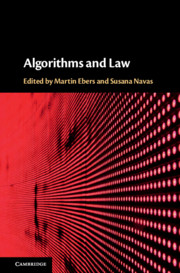Book contents
- Algorithms and Law
- Algorithms and Law
- Copyright page
- Contents
- List of Figures and Tables
- Notes on Contributors
- Preface
- Acknowledgments
- 1 Robotics and Artificial Intelligence
- 2 Regulating AI and Robotics
- 3 Regulating Algorithms
- 4 Automated Decision-Making under Article 22 GDPR
- 5 Robot Machines and Civil Liability
- 6 Extra-Contractual Liability for Wrongs Committed by Autonomous Systems
- 7 Control of Algorithms in Financial Markets
- 8 Creativity of Algorithms and Copyright Law
- 9 “Wake Neutrality” of Artificial Intelligence Devices
- 10 The (Envisaged) Legal Framework for Commercialisation of Digital Data within the EU
9 - “Wake Neutrality” of Artificial Intelligence Devices
Published online by Cambridge University Press: 04 July 2020
- Algorithms and Law
- Algorithms and Law
- Copyright page
- Contents
- List of Figures and Tables
- Notes on Contributors
- Preface
- Acknowledgments
- 1 Robotics and Artificial Intelligence
- 2 Regulating AI and Robotics
- 3 Regulating Algorithms
- 4 Automated Decision-Making under Article 22 GDPR
- 5 Robot Machines and Civil Liability
- 6 Extra-Contractual Liability for Wrongs Committed by Autonomous Systems
- 7 Control of Algorithms in Financial Markets
- 8 Creativity of Algorithms and Copyright Law
- 9 “Wake Neutrality” of Artificial Intelligence Devices
- 10 The (Envisaged) Legal Framework for Commercialisation of Digital Data within the EU
Summary
This chapter introduces the notion of “wake neutrality” of artificial intelligence devices and reviews its implication for wake-word approaches in open conversational commerce (OCC) devices such as Amazon’s Alexa, Google Home and Apple’s Siri. Examples illustrate how neutrality requirements such as explainability, auditability, quality, configurability, institutionalization, and non-discrimination may impact the various layers of a complete artificial intelligence architecture stack. The legal programming implications of these requirements for algorithmic law enforcement are also analysed. The chapter concludes with a discussion of the possible role of standards bodies in setting a neutral, secure and open legal programming voice name system (VNS) for human-to-AI interactions to include an “emotional firewall.”
- Type
- Chapter
- Information
- Algorithms and Law , pp. 235 - 268Publisher: Cambridge University PressPrint publication year: 2020
- 5
- Cited by

